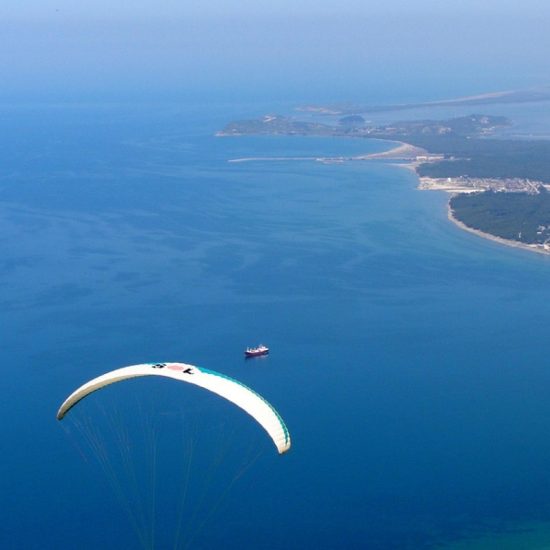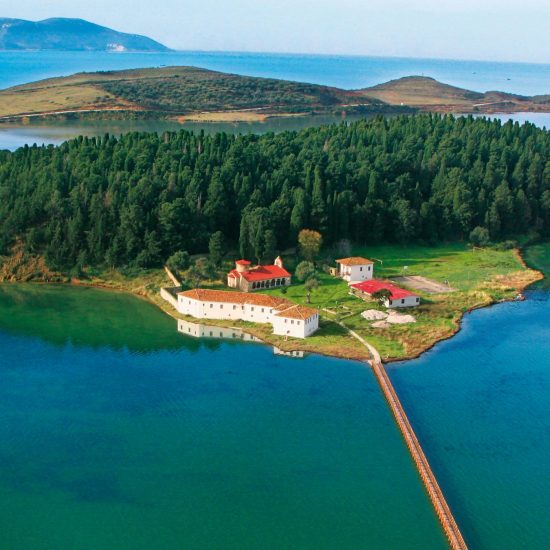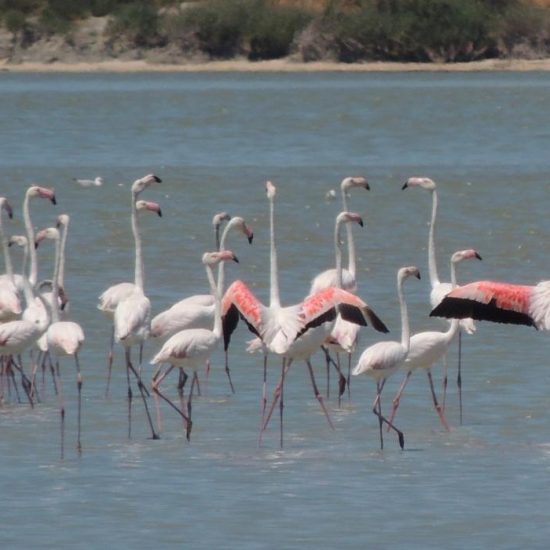Vlora
Vlora is one of the largest and most populous cities in Albania. It is 130 km from the capital, 120 km from Mother Teresa International Airport and is home to the second largest port in Albania. Vlora is rich in history and antiquity. This historic city dates back to the 6th century BC when it was known as Aulon. Fragments of a massive wall surrounding Aulon were found in the center of the city, not far from the Square of the Banner of Shesha and Flamurit. In 1081 the city fell under the rule of Normandy. In the 14th century it was part of the kingdom of Arberia ruled by the Balshai, Albanian princes, until 1417 when the city was captured by the Ottomans. In 1812, the city came under the control of Ali Pasha Tepelena, and a century later, on November 28, 1912, it became the first capital of independent Albania under the government of Ismail Qemali. The most interesting sights of Vlora are the Museum of Independence (at the headquarters of the first government), the Historical Museum, the Ethnographic Museum. Among the religious sites in Vlora, one of the most important is the Muradiye Mosque, built in 1542 by the chief architect of the Ottoman Empire, Mimar Sinani, who came from the region. He is the builder of the famous Suleymaniye Mosque in Istanbul and is also known for his work in other Turkish cities such as Edirne (for the Selimiye Mosque), Erzurum and others. In addition, on a prominent hill above the city is the Bektashi Kuzum Babai tekke. The site offers an amazing view of the city of Vlora, Karaburun Island, Sazan Island and Narta Lagoon. The city of Vlore also has some interesting clubs and restaurants. built in 1542 by the chief architect of the Ottoman Empire, Mimar Sinani, former native of the region. He is the builder of the famous Suleymaniye Mosque in Istanbul and is also known for his work in other Turkish cities such as Edirne (for the Selimiye Mosque), Erzurum and others. In addition, on a prominent hill above the city is the Bektashi Kuzum Babai tekke. The site offers an amazing view of the city of Vlora, Karaburun Island, Sazan Island and Narta Lagoon. The city of Vlore also has some interesting clubs and restaurants. built in 1542 by the chief architect of the Ottoman Empire, Mimar Sinani, a former native of the region. He is the builder of the famous Suleymaniye Mosque in Istanbul and is also known for his work in other Turkish cities such as Edirne (for the Selimiye Mosque), Erzurum and others. In addition, on a prominent hill above the city is the Bektashi Kuzum Babai tekke. The site offers an amazing view of the city of Vlora, Karaburun Island, Sazan Island and Narta Lagoon. The city of Vlore also has some interesting clubs and restaurants. on a prominent hill above the city is the Bektashi Kuzum Babai tekke. The site offers an amazing view of the city of Vlora, Karaburun Island, Sazan Island and Narta Lagoon. The city of Vlore also has some interesting clubs and restaurants. on a prominent hill above the city is the Bektashi Kuzum Babai tekke. The site offers an amazing view of the city of Vlora, Karaburun Island, Sazan Island and Narta Lagoon. The city of Vlore also has some interesting clubs and restaurants. The site offers an amazing view of the city of Vlora, Karaburun Island, Sazan Island and Narta Lagoon. The city of Vlore also has some interesting clubs and restaurants. on a prominent hill above the city is the Bektashi Kuzum Babai tekke. The site offers an amazing view of the city of Vlora, Karaburun Island, Sazan Island and Narta Lagoon. The city of Vlore also has some interesting clubs and restaurants. The site offers an amazing view of the city of Vlora, Karaburun Island, Sazan Island and Narta Lagoon. The city of Vlore also has some interesting clubs and restaurants. on a prominent hill above the city is the Bektashi Kuzum Babai tekke. The site offers an amazing view of the city of Vlora, Karaburun Island, Sazan Island and Narta Lagoon. The city of Vlore also has some interesting clubs and restaurants.
Narta
To the north of the city of Vlora is Narta Lagoon, the second largest lagoon in Albania. The area is home to 195 species of waterfowl, and Mediterranean forests cover the area separating the lagoon from the sea. This is a good place to watch seabirds or go fishing. The water is saturated with various species of aquatic fauna, especially eel and sea bass. The village of Narta stands south of the lagoon on the water’s edge and is surrounded by low hills covered with vineyards that produce some of the finest artesian wines in Albania. The lagoon offers a picturesque view of the village of Zvernets and the neighboring island, on which there is a Byzantine-style church and the monastery of St. Mary. The lagoon ends at Cape Treporta, which connects with a forested hill, forming a beautiful natural landscape.
Radhima
As you continue your journey south, you will enjoy a panoramic view of this part of Vlora Bay. Passing through the tunnel in the area known as Uji i Ftohtë (Cold Water), named after a nearby mountain stream flowing into the sea, you will see the tourist area of Yonufry with its small rocky beaches famous for their crystal clear waters. Beyond Yonufri lies Radhima, which runs for several kilometers to the Dukat stream, near the small town of Orikum. The beaches at Radhima have wonderful colors with bright contrasts between the deep blue sea and the green hills with their Mediterranean olive and citrus plantations. Vlora Bay is also an ideal place for diving. There are several wrecks, such as PO, an Italian hospital ship sunk in 1941 during World War II.
Orikumi
The small town of Orikum is located at the southern end of Vlore Bay, close to a marina that can accommodate 650 yachts. Oricum was one of the most important cities of the ancient world; settlers from the island of Euboea founded it during their retreat from the Trojan War. The strategic position of Orikum made it the main port of the Illyrian Amante clan and played an important role in the civil wars between Caesar and Pompey. During the Byzantine period, the small port of Orikumi received the holy name “Jericho” due to the presence of the Jewish community in the bay of Vlore. During the Ottoman occupation, Orikumi took the name Pasha Liman. The most important archaeological structure is the ancient theater Orikumi, for 400-500 seats. Another attraction is the Marmiroi church of the Byzantine period. Orikumi is a good starting point if you want to explore Karaburun Island, which covers the western part of the Gulf of Vlore. The western coast of Karaburun is striking, with small bays and isolated beaches with deep, clear waters. The sea cave of Hadji Alia, a 17th century sailor from Ulcinj, is located to the north of the peninsula. On the steep slopes near Grame beach, whose name comes from the Greek word Gramata, ancient writings were found. There must be an ancient temple to Ledea, a Pelasgian princess, on this site. lies to the north of the peninsula. Antique inscriptions have been found on the steep slopes near Grame Beach, whose name comes from the Greek word Gramata. There must be an ancient temple to Ledea, a Pelasgian princess, on this site. lies to the north of the peninsula. On the steep slopes near Grame beach, whose name comes from the Greek word Gramata, ancient writings were found. The western coast of Karaburun is striking, with small bays and isolated beaches with deep, clear waters. The sea cave of Hadji Alia, a 17th century sailor from Ulcinj, is located to the north of the peninsula. On the steep slopes near Grame beach, whose name comes from the Greek word Gramata, ancient writings were found. There must be an ancient temple to Ledea, a Pelasgian princess, on this site. lies to the north of the peninsula. Antique inscriptions have been found on the steep slopes near Grame Beach, whose name comes from the Greek word Gramata. There must be an ancient temple to Ledea, a Pelasgian princess, on this site. lies to the north of the peninsula. On the steep slopes near Grame beach, whose name comes from the Greek word Gramata, ancient writings were found. The western coast of Karaburun is striking, with small bays and isolated beaches with deep, clear waters. The sea cave of Hadji Alia, a 17th century sailor from Ulcinj, is located to the north of the peninsula. On the steep slopes near Grame beach, whose name comes from the Greek word Gramata, ancient writings were found. There must be an ancient temple to Ledea, a Pelasgian princess, on this site. lies to the north of the peninsula. Antique inscriptions have been found on the steep slopes near Grame Beach, whose name comes from the Greek word Gramata. There must be an ancient temple to Ledea, a Pelasgian princess, on this site. lies to the north of the peninsula. On the steep slopes near Grame beach, whose name comes from the Greek word Gramata, ancient writings were found. with small bays and isolated beaches with deep and clear water. The sea cave of Hadji Alia, a 17th century sailor from Ulcinj, is located to the north of the peninsula. On the steep slopes near Grame beach, whose name comes from the Greek word Gramata, ancient writings were found. There must be an ancient temple to Ledea, a Pelasgian princess, on this site. lies to the north of the peninsula. Antique inscriptions have been found on the steep slopes near Grame Beach, whose name comes from the Greek word Gramata. There must be an ancient temple to Ledea, a Pelasgian princess, on this site. lies to the north of the peninsula. On the steep slopes near Grame beach, whose name comes from the Greek word Gramata, ancient writings were found. with small bays and isolated beaches with deep and clear water. The sea cave of Hadji Alia, a 17th century sailor from Ulcinj, is located to the north of the peninsula. On the steep slopes near Grame beach, whose name comes from the Greek word Gramata, ancient writings were found. There must be an ancient temple to Ledea, a Pelasgian princess, on this site. lies to the north of the peninsula. Antique inscriptions have been found on the steep slopes near Grame Beach, whose name comes from the Greek word Gramata. There must be an ancient temple to Ledea, a Pelasgian princess, on this site. lies to the north of the peninsula. On the steep slopes near Grame beach, whose name comes from the Greek word Gramata, ancient writings were found. On the steep slopes near Grame beach, whose name comes from the Greek word Gramata, ancient writings were found. There must be an ancient temple to Ledea, a Pelasgian princess, on this site. lies to the north of the peninsula. Antique inscriptions have been found on the steep slopes near Grame Beach, whose name comes from the Greek word Gramata. There must be an ancient temple to Ledea, a Pelasgian princess, on this site. lies to the north of the peninsula. On the steep slopes near Grame beach, whose name comes from the Greek word Gramata, ancient writings were found. On the steep slopes near Grame beach, whose name comes from the Greek word Gramata, ancient writings were found. There must be an ancient temple to Ledea, a Pelasgian princess, on this site. lies to the north of the peninsula. Antique inscriptions have been found on the steep slopes near Grame Beach, whose name comes from the Greek word Gramata. There must be an ancient temple to Ledea, a Pelasgian princess, on this site. lies to the north of the peninsula. On the steep slopes near Grame beach, whose name comes from the Greek word Gramata, ancient writings were found. whose name comes from the Greek word Gramata, ancient inscriptions have been found. There must be an ancient temple to Ledea, a Pelasgian princess, on this site. lies to the north of the peninsula. On the steep slopes near Grame beach, whose name comes from the Greek word Gramata, ancient writings were found. whose name comes from the Greek word Gramata, ancient inscriptions have been found. There must be an ancient temple to Ledea, a Pelasgian princess, on this site. lies to the north of the peninsula. On the steep slopes near Grame beach, whose name comes from the Greek word Gramata, ancient writings were found.
Amantia
The ruins of the ancient city of Amantia stand southeast of the Vlora region, near the village of Plloche. Amantia was declared an archaeological park in 2005. It was the capital of the Illyrian Amants tribe. It was founded in the 5th century BC and covered an area of 13 hectares. The most interesting buildings for visitors are the ancient stadium of Amantia, 60 m long and 12.5 m wide, as well as fortifications.
Apollonia
The distance from Vlora to Fira is 34 km, and to Apollonia is 12 km. The city of Apollonia, named after the Greek god Apollo, was founded in the early 7th century BC by Corinthian settlers. The first documents about the presence of settlers date back to 588 BC. Among the 24 cities of the ancient Mediterranean with the same name, Illyrian Apollonia was the most important, since it served as a trading point between the Illyrians and the ancient Greeks. The city remained equally prominent throughout the Roman period; Here Octavian August studied oratory. Huge territory covered with archaeological ruins, beautiful view of the Miseke plain and the Adriatic Sea




